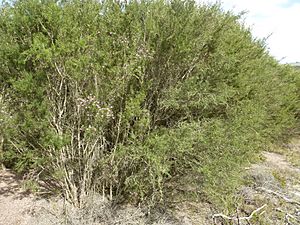Melaleuca pentagona facts for kids
Quick facts for kids Melaleuca pentagona |
|
|---|---|
 |
|
| M. pentagona growing near the Esperance wetlands. | |
| Scientific classification | |
| Genus: |
Melaleuca
|
| Species: |
pentagona
|
Melaleuca pentagona is a beautiful plant from the myrtle family called Myrtaceae. It grows only in the southern parts of Western Australia. This medium-sized shrub is quite showy. It produces many pink flowers, especially in spring. There are three different types, or varieties, of this plant. One type has been grown in gardens for many years.
Contents
What Melaleuca pentagona Looks Like
Melaleuca pentagona is a shrub that can grow up to about 5 meters (16 feet) tall. It has interesting bark that looks like paper and is grey or white. Its leaves are placed one after another along the stem. They are usually 8 to 18 millimeters (0.3 to 0.7 inches) long. The leaves are narrow and have a groove on their top surface.
Flowers and Fruit
The flowers are pink or purple. They grow in round groups at the ends of branches. These branches keep growing even after the flowers bloom. Sometimes, flowers also appear where the leaves meet the stem. Each flower group can be up to 20 millimeters (0.8 inches) wide. They contain 3 to 8 smaller groups of three flowers.
The small petals are about 0.9 to 2 millimeters (0.04 to 0.08 inches) long. They fall off as the flowers open. The flower has five groups of stamens. These are the parts that produce pollen. Each group has 2 to 8 stamens. This plant usually flowers in spring and summer. After flowering, it produces woody fruits. These fruits are like small capsules, about 2.5 to 3.5 millimeters (0.10 to 0.14 inches) long. They grow in round clusters up to 20 millimeters (0.8 inches) wide.
Plant Names and History
The plant Melaleuca pentagona was first officially described in 1806. A French scientist named Jacques Labillardière wrote about it. He included it in his book Novae Hollandiae Plantarum Specimen.
Meaning of the Name
The second part of its name, pentagona, comes from Ancient Greek words. "Pénte" means "five," and "gōnía" means "angle." This name refers to the fruit capsules. They are pressed together into a five-sided shape.
Different Types of Melaleuca pentagona
Scientists recognize three different types, or varieties, of this plant:
- Melaleuca pentagona var. latifolia: This type grows near Esperance, Israelite Bay, and Toolinna. It flowers in late spring. You can find it in sandy soils near salt lakes.
- Melaleuca pentagona var. pentagona: This type grows near Mount Barker, Albany, and Esperance. It flowers mostly in spring and summer. It grows in sandy, clay, or gravelly soil.
- Melaleuca pentagona var. raggedensis: This type is found in Cape Arid National Park. It grows in sandy or stony soil, often near granite rocks. Its name comes from Mount Ragged, where it grows.
Where It Grows
Melaleuca pentagona grows in several different natural areas in Western Australia. These areas include the Avon Wheatbelt, Coolgardie, Esperance Plains, Jarrah Forest, Mallee, and Warren regions.
Environmental Impact
Sometimes, this type of Melaleuca plant can become a problem. In some parts of Western Australia, it grows too much. It can take over areas where other native plants should be. This makes it an "environmental weed."
Protecting the Plant
The government of Western Australia's Department of Parks and Wildlife says this plant is "not threatened." This means it is not currently in danger of disappearing.
Growing in Gardens
The variety Melaleuca pentagona var. pentagona is popular for growing in gardens. It can grow well in many different types of soil and conditions.
Images for kids
-
Habit near the Esperance wetlands





